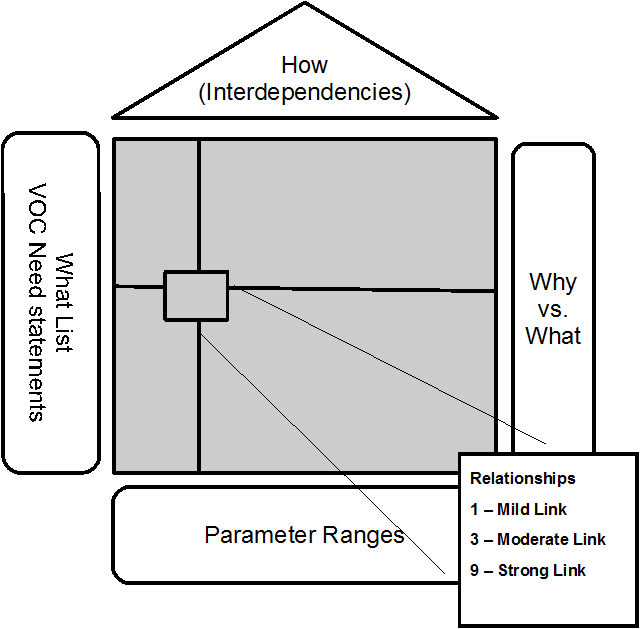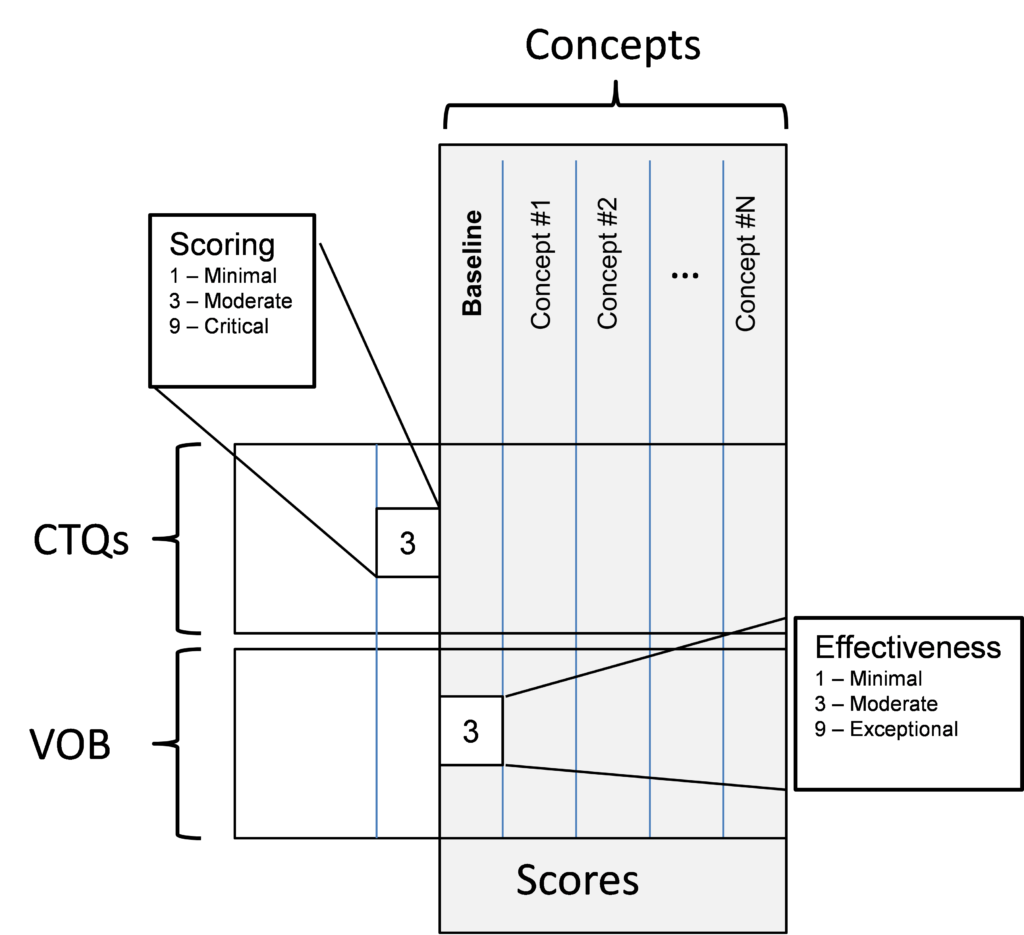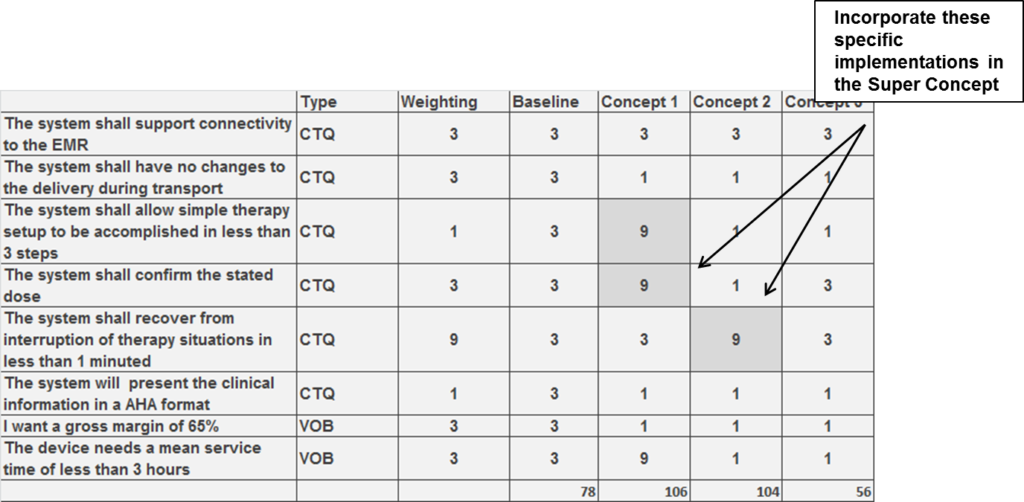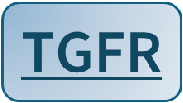Concept Development using QFDs and Super Concepts
The process of concept development requires two integrated activities
- The identification of CTQs using the QFD. CTQs consist of those performance parameters that drive customer satisfaction. The QFD activity identifies the CTQs
- The evaluation and selection of concepts using the Super Concept process. Success iterations create and evaluate concepts against the CTQs (VOC) and Voice of the Business (VOB)
The process differs from a strict QFD process in several ways:
- The QFD is used to drive the identification of the key performance parameters associated with meeting the needs of the customer, CTQs, independent of any VOB criteria
- Concept Selection uses an iterative process, using a Pugh Matrix that evaluates the concepts against the VOB and CTQs.
- During the iterative evaluation of the concepts, the best elements of the competing concepts are integrated to form a super concept. This super concept will be evaluated along with other variants in subsequent iterations.
The QFD (Quality Function Deployment)
Following the identification of the performance parameters, a QFD is constructed and evaluated. A number of books have been written about the QFD process and the level of complexity and detail associated with the QFD execution can be subject to a great deal of debate. The process detailed here will focus on performance parameter identification, and many of the other potential outputs of the process will be ignored. The basic structure of the QFD is shown below

QFD Structure
For the QFD, and the mapping of the elements is as follows
- What List (rows) – the user needs (VOC). At this point in the process, the VOB is not considered.
- How (columns) – the features as developed. Initial ranges are developed.
The preferred structure of the QFD for CTQ identification is that every row has an importance rating, based upon a 1/3/9 rating scale. This 1/3/9 importance rating allows the easy discrimination of the key user needs. The use of a linear 1-5 scale is not recommended. With a linear scale, importance is compressed (everything tends to the same score) and discrimination is lost. With a 1/3/9 scale, the weighting favors the most important, but care should be taken to limit the “9” weighting to 1-2 user needs. Otherwise the “Lake Wobegon” effect (all the children are above average) takes over and discrimination is lost.
Scoring the interactions of the features against the user needs scoring also uses 1/3/9 scale. The following definitions should be applied
- 9 – This performance parameter (feature) could, on its own, deliver 75%-100% on this issue/need
- 3- This performance parameter (feature) could, on its own, deliver 25%-75% on this issues/need. Other features will be needed to fully deliver on this issue/need
- 1 – This performance parameter (feature) has an effect of less than 25% on delivery of this issue/need
- Blank – This feature (performance parameter)has no effect on how this issue/need is satisfied
The standard QFD process involves moving the value of a performance parameter over its range and evaluating the changes in its ability to deliver on the user needs. Upon completion of the process the most important performance parameters are identified, and these parameters are the CTQs. A QFD/CTQ process which results in identifying more than one or two CTQs may require adjustments to the weighting and interaction scoring. The identification of too many CTQs usually adversely impacts the selection of a concept and subsequent tradeoffs. In this situation where the QFD process identifies too many CTQs, re-evaluation of the user need ratings and interaction scoring should be undertaken to determine reduce the set of CTQs identified.
As an example of a situation of conflicting CTQs, consider a QFD process for cell phones and other portable devices. In considering the CTQs for cell phones and other portable devices, the CTQs of light weight and long battery life tend to be in conflict. Review and re-execution of the CTQ process forces determination of exactly which of these performance parameters represents the CTQ.
The QFD process develops the CTQs for the device, but the results must represent a set of identified CTQs that the team and the business can agree represent the critical features. These CTQs must be clear and without conflicts that will impact the later concept selection activities.
Concept Development using Super Concepts
Evaluating specific concepts leverages the CTQs and VOB to determine the best overall concept. The evaluation uses a iterative approach based upon several iterations of a Pugh Matrix. The Pugh Matrix scores alternative concepts against a weighted set of criteria. The Pugh Matrix criteria are based upon the CTQs and the VOB established during previous steps. These criteria become the weighted rows of the Pugh Matrix, and the alternative concepts become the columns. Rows are weighted using a 1/3/9 scale as with the QFD based upon the following criteria.
- Only 1 or 2 of the assessment criteria is assigned a value of 9
- The total weight of the rows associated with the CTQs account for 70% of the total weight across all rows
- The total weight of the VOB account no more than 30% of the total weight
Adherence to the guidelines for the total weight assigned to the CTQs versus the total weight assigned to the VOB is critical. Weighting the VOB rows in the Pugh Matrix too heavily creates the risk that the final concept will meet the VOB at the expense of the user needs as reflected in the CTQs. Customer needs drive the CTQs, and a weighting distribution without a bias towards these user needs may result in the selection of a concept that meets the business needs at the expense of the customer needs. In this situation the process may have a selected a great product that will not appeal to customers.

Pugh Matrix Structure
Pugh Matrix scoring also follows the 1/3/9 value scale. While many Pugh Matrix discussions favor a +/-/0 subjective scaling, working with numbers and scores often provides a easier framework for the evaluation team to understand.
Concepts, whenever possible, should be developed by competing teams to drive diverse thinking. Following the development and detailing of the concept, the competing teams should get together and collectively score the concepts. This process will build understanding and drive the associated Super Concept process.
The Super Concept process forces at least one round of synthesis, where the best features of each proposed concept are combined into a Super Concept for the next iteration of the concept generation process. The following shows how Super Concept features are driven out of the evaluation process

Super Concept Identification
To achieve the best concept, several iterations of concept development and scoring should be undertaken. At the point where the teams consider the differences in scoring insignificant, the scoring within the Pugh Matrix is completed and the final concept identified.
 TGFR Consulting LLC
TGFR Consulting LLC